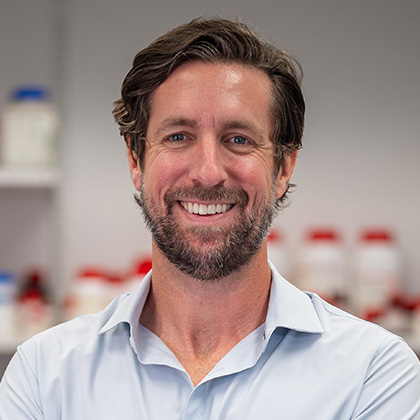Tagliabracci receives ASBMB’s Stadtman Young Scholar Award

Vincent Tagliabracci, Ph.D., Associate Professor of Molecular Biology and a member of the Harold C. Simmons Comprehensive Cancer Center, received the Earl and Thressa Stadtman Young Scholar Award from the American Society for Biochemistry and Molecular Biology (ASBMB). The award recognizes significant contributions to biochemistry and molecular biology by a scientist with less than 15 years of experience since earning a Ph.D. or M.D.
“I am honored and humbled to receive this award, especially knowing that it has been given to so many incredible scientists before me,” said Dr. Tagliabracci, who is also a Howard Hughes Medical Institute Investigator. “Although I never had the opportunity to meet Earl and Thressa, their work has profoundly influenced my own. Thressa’s research introduced me to selenoproteins, while Earl’s work taught me about adenylylation, also known as AMPylation. In an interesting twist of fate, in 2018, we discovered a selenoprotein that functions as an adenylyltransferase.”
Dr. Tagliabracci, who was nominated by Molecular Biology Chair and Professor Eric Olson, Ph.D., is being honored for his lab’s discovery of diverse and unexpected biochemical activities performed by protein kinases, including AMPylation, polyglutamylation, and messenger RNA capping. These findings have provided new insights into the cellular response to oxidative stress and the pathogenic mechanisms used by bacterial and viral pathogens.
All organisms encode catalytic proteins known as enzymes, which drive the diverse chemical reactions essential for life, Dr. Tagliabracci explained. Almost every enzyme family has relatives thought to be catalytically inactive because they lack key amino acid signatures present in their active counterparts. These “dead” enzymes are known as pseudoenzymes or “zombie enzymes.” And while widespread in nature, their functions often remain unknown.
“We have discovered that some pseudoenzymes are, in fact, active enzymes, but they perform different chemical reactions than their active counterparts,” he said. “Many diseases are caused by changes or disruptions in enzyme activity. By understanding how these changes affect the molecules that enzymes normally work on, we can gain important insights into how these diseases develop and possibly find ways to treat them.”
The Tagliabracci Lab has made significant progress in uncovering new activities for pseudokinases using a combination of bioinformatics, biochemistry, and structural biology.
“With the advent of the artificial intelligence program AlphaFold, which enables accurate 3D structural predictions of proteins, we’re now leveraging structure-based bioinformatics to discover new kinases and other enzymes,” Dr. Tagliabracci said.
The Stadtman Award includes a plaque, $10,000 cash prize, and an invitation to speak at ASBMB’s 2025 annual meeting in Chicago in April.
Among his many honors, Dr. Tagliabracci received the 2024 Edith and Peter O’Donnell Award in Biological Sciences from the Texas Academy of Medicine, Engineering, Science and Technology (TAMEST) and the 2020 Norman Hackerman Award in Chemical Research. He also is a Searle Scholar and a Cancer Prevention Research Institute of Texas (CPRIT) Scholar.
After earning a Bachelor of Science in chemistry and biology from the University of Indianapolis and a Ph.D. in biochemistry and molecular biology from Indiana University, Dr. Tagliabracci served as a postdoctoral fellow at the University of California, San Diego. He joined the UTSW faculty in 2015.

